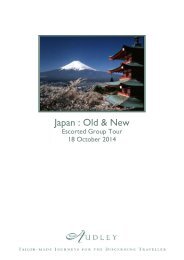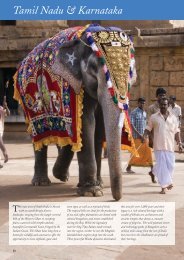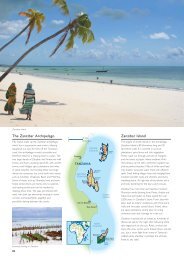Download - Audley Travel
Download - Audley Travel
Download - Audley Travel
You also want an ePaper? Increase the reach of your titles
YUMPU automatically turns print PDFs into web optimized ePapers that Google loves.
Kinkaku-ji Golden Pavilion, Kyoto<br />
Shrine gates, Fushimi, Kyoto<br />
Ikebana teacher<br />
Traditional crafts<br />
& pastimes<br />
Japan is rightly famed for the delicacy<br />
and refinement of its traditional crafts<br />
and pastimes, such as ikebana flower<br />
arranging, origami, bonsai and the tea<br />
ceremony. The Women’s Association<br />
of Kyoto has established a range of<br />
short introductions to various aspects<br />
of Japanese culture, craft and cookery<br />
that allow you to visit a real Japanese<br />
home and try your hand at traditional<br />
skills. Courses are run by local women<br />
keen to share their hobbies and skills<br />
with visitors, and offer you the chance<br />
to enrich your time in Japan by<br />
interacting with local people on an<br />
individual level.<br />
Todai-ji Temple, Nara<br />
Mount Koya<br />
Guardian statue at Todai-ji Temple, Nara<br />
Nara<br />
A short train ride from Kyoto is historic Nara, an<br />
earlier capital. While Kyoto’s continuing eminence<br />
over the centuries has led to its development into<br />
a large, bustling city, the significance of Nara soon<br />
waned once the capital was relocated, and today<br />
it is a relaxed town with some beautiful sights.<br />
Nara residents are justifiably proud of the Todai-ji<br />
Temple, which houses Japan’s largest bronze<br />
Buddha, as well as the tranquil expanses of the<br />
surrounding deer park where the sacred deer are<br />
so little afraid of humans that they will eat food<br />
out of your hand. Nara can easily be visited as a<br />
day trip from Kyoto or as an overnight stay for<br />
those with more time.<br />
High in the forested mountains of the Kii<br />
Peninsula, south of Osaka, lies the monastic<br />
complex of Mount Koya, the home of the esoteric<br />
Shingon Buddhist sect. Recently designated a<br />
UNESCO World Heritage Site, the town contains<br />
more than a hundred different temples, many of<br />
which offer lodging for pilgrims and visitors,<br />
allowing you to join the monks in their daily<br />
routines, share their delicious vegetarian cuisine,<br />
and experience a very different aspect of Japanese<br />
society. Take a stroll at dusk along the winding,<br />
lantern-lit paths through the Okuno-in cemetery<br />
for a uniquely atmospheric experience. Other<br />
temples across Japan offer similar opportunities<br />
to stay and join in the monastic life; please<br />
speak to our specialists for more information.<br />
Konpon Daito Temple, Mount Koya<br />
Monk, Mount Koya<br />
TENTOKU-IN SHUKUBO,<br />
MOUNT KOYA<br />
Known as ‘shukubo’, the accommodation here<br />
was originally designed for the Buddhist monks<br />
and pilgrims who visited the temple for training<br />
or worship, but is now open to members of the<br />
public. The food served here is shojin, which is<br />
vegetarian in accordance with Buddhist practices.<br />
Rooms are quite small and basic, but quaintly<br />
Japanese in style with tatami flooring and sliding<br />
rice paper doors. Your futon bed is made up in<br />
the evening and some guest rooms have views<br />
over the superb Japanese garden, accredited to<br />
master garden designer Kobori Enshu, at the<br />
centre of the temple.<br />
www.audleytravel.com/japan ● 01993 838 210 ● Central Japan 15

















